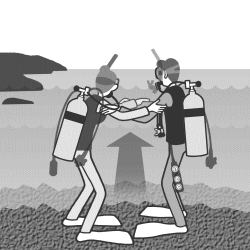■Wading Entry
This is the recommended entry when waves are high during a beach entry. Facing your dive buddy and joining arms, you approaching the surf together. Standing sideways to the waves now, you and your partner support each other as you each take small steps, taking into account the timing of the wave breaks. Once you’ve reached a suitable point to descend, diving below the waves quickly will ensure as smooth an entry as possible. |

Work With Your Dive Buddy |

